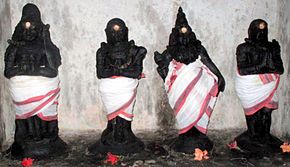- Cuntarar
-
The 3 foremost Nayanars with Manikkavacakar - collectively called the Nalvars: (from left) Campantar, Appar, Suntharar, Manikkavacakar.

Tirumurai The twelve volumes of Tamil Shaivite hymns of the sixty-three Nayanars 1, 2, 3. Tirukadaikkappu Campantar 4, 5, 6. Tevaram Appar 7. Tirupaatu Cuntarar 8. Tiruvacakam and Tirukkovaiyar Manikkavacakar 9. Tiruvisaippa & Tiruppallaandu Various poets 10. Tirumandhiram Tirumular 11. Prabandham Various poets 12. Periya Puranam Sekkizhar Suntarar (Tamil சுந்தரர், 8th C.C.E.), also known as Sundaramurti, was one of the most prominent among the Nayanars, the Shaiva bhakti (devotional) poets of Tamil Nadu. He was a contemporary of Cheraman Perumal and Kotpuli Nayanar who also figure in the 63 Nayanmars.[1][2] The songs of praise are called Thiruthondathogai and is the original nucleus around which the Periyapuranam is based.[3] The Periya Puranam, which collects the legends of the Nayanars, starts and ends with him. The hymns of seventh volume of the Tirumurai, the twelve-volume compendium of the poetry of Tamil Shaiva Siddhanta, were composed by him.
Contents
Life
Cuntarar is unique among the Nayanars in that both of his parents are also recognised as Nayanars. He was born Nambi Arurar to an Adi Shaiva (temple priest) brahmin couple, Sadayanar and Isaignani, in the village of Tirunavalur. The ruler of the local kingdom (Thirumunaipadi-Nadu), Narasingamunaiarayar, adopted him and brought up as his own son, attracted by the beauty of the child he saw playing in the street.
Legend states[who?] that while Cuntarar was being married, the service was interrupted by an old ascetic who asked for Cuntarar as his servant, claiming that Cuntarar's grandfather pledged him according to an ancient palm leaf manuscript in his possession. Cuntarar and those assembled at the wedding were outraged and called the old man a madman (piththaan: Tamil). But a court of Vedic scholars concluded that the palm leaf was legally valid. Crestfallen, Cuntarar resigned himself to servitude in the old man's household and, following him to Thiruvennainallur village, was led to the Thiruvarutturai Shiva temple.
The old man was said to be Shiva himself, who told him: "You will henceforth be known as Vanthondarm, the argumentative devotee. Did you not call me a mad man just a short while ago? Begin your hymn addressing me 'O mad man!'".[4]
Subsequently, Cuntarar moved around Tamil Nadu, visiting several Shiva Temples of Tamil Nadu. In Tiruvarur, in the Thanjavur district, he fell in love with a girl named Paravayar, of the Rudra Kanyakayar caste of female ascetics, and married her. The poet himself mentions his two children; Vanapakai and Cinkati.
In Thiruvottriyur, a sea-side suburb of Madras, he prayed at the Padampakkanathar/Thyagarajar/Vadivudaiamman Temple, where he saw a farmer's girl, Sangiliyar, who was preparing flower garlands and married her, promising never to leave.[4]
The legend states that at Tiruvarur he recited the names of all sixty-three future Nayanars: this recitation is called Tiruttondar-Tokai. In it, he refers to himself as the servant of servants of these saints.[3] His fame reached the ears of the Cheraman Perumal, who came to Tiruvarur. Both embarked on a pilgrimage. But Cuntarar became tired of life and was taken up to heaven by a white elephant. The king followed him on his horse. This occurred in "Swathi Nakshtra" in the Tamil month of "Aadi".
List of temples reputedly visited by Cuntarar
Tiruvarutturai Temple at Tiruvenai Nallur, Tirunaavaleswarar Temple at Tirunavalur, Turaiyurppesurar Temple at Trurhuraiyur (Tirutarur), Nataraja Temple at Thillai(Chidambaram), Tiruvadhigai Veerattaanam Temple at Tiruvadhigai, Manikkamenivaradhar Temple at Tirumanikusi (Thirumaandakuzhi), Tirundheeswarar Temple at Tirurinainagar (Teerthanagiri), Brahmapuresar Temple at Sirgasi, Saptapreswarar Temple at Tirukolaka, Shivaloganaathar Temple at Tirupungur, Mayooranaathar Temple at Mayiladuturai(Maayooram), Tiruvambar Maakaalam Temple at Tiruvambar (Ambal), Agnipuriswarar Temple at Tirupugalur, Tyageapruman Temple at Tiruvarur, Kolilinathar Temple at Tirukkolili (Tirukuvalai), Karinateswarar Temple at Tirunatiyathankudi, Manatunainatar temple at Tiruvalivalam, Cuntareswarar Temple at Tirupanaiyur, Prakasheswarar Temple at Tirunanilam (nannilam), Vizhiyasagar Temple at Tiruvisimasalai, Vanjaligeswarar Temple at Tiruvanjiyam, Swarnapuresar Temple at Trikaduvaikarai Putur, Cuntarareswarar Temple at Tirunaraiyur, Padikalitta Eeswarar Temple at Arisirkarai Putur (Azhagar Puthur), Masilamaiyisar Temple at Tiruvavaduthurai, Marudappar Temple at Tiruvidaimarudur, Shenbagaranyeswarar Temple at Tirunageswaram, Brahmapuri Nayagar Temple at Tiruchivapuram, Amirdhakalayeswarar Temple at Torukalayanalur (Saakkottai), Kumeswarar Temple at Tirukudamuku (Kumbakonam), Sithisar Temple at Tiruvalanjusi, Periyandeswarar Temple at Tirunallur, Tolayacelvesar Temple at Tiruchotruturai, Virataneswarar Temple at Tirukkandiyur, Panchanadhiswarar Temple at Tiruvaiyaru, Pushpavananadheswarar Temple at Tirupundhuruti, Atmanadeswarar Temple at Tiruvalamposil and Vajranadeswara Temple at Tirumasabadi.
Notes
References
- Dictionary of Hindu Lore and Legend (ISBN 0-500-51088-1) by Anna Dallapiccola
- Songs of the harsh devotee by David Dean Shulman
- The religion and philosophy of thevaram by M.A. Dorai Swamy
- Development of Religion in South India by K. A. Nilakanta Sastri
- Arupathu Moovar Kadhaigal by Durgadas S. K. Swamy (Prema Pirasuram publishers)
- Origin and early history of Śaivism in South India By Sadananda (Swami.)
- Ten saints of India By T. M. P. Mahadevan
- A short introduction to Saivism By Subodh Kapoor
- Songs of Sundararmoorthy Swamigal
- Life of Sundaramoorthy Swamigal
Categories:- Nayanar saints
Wikimedia Foundation. 2010.

